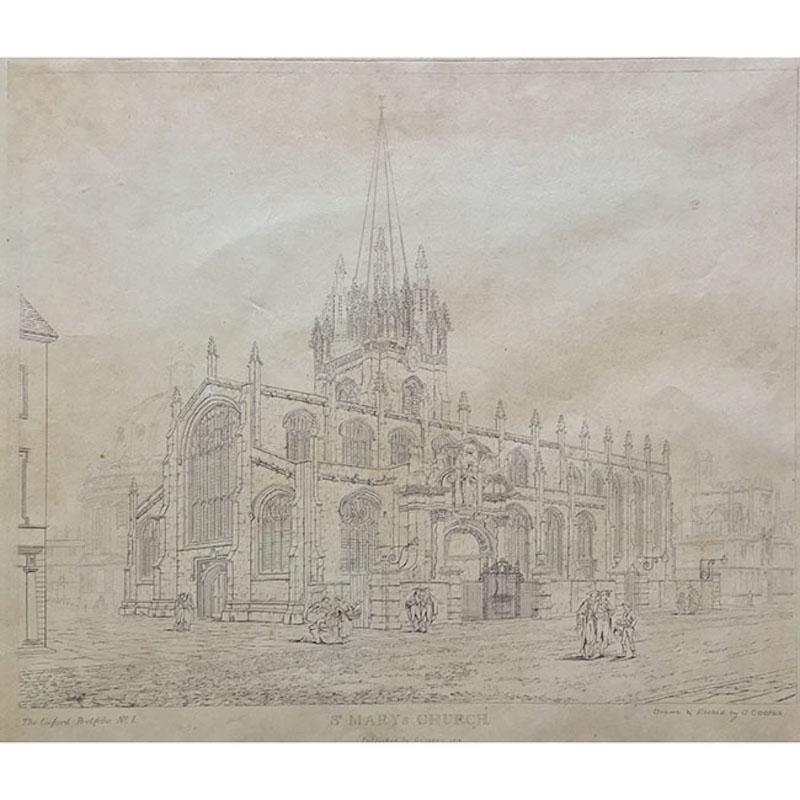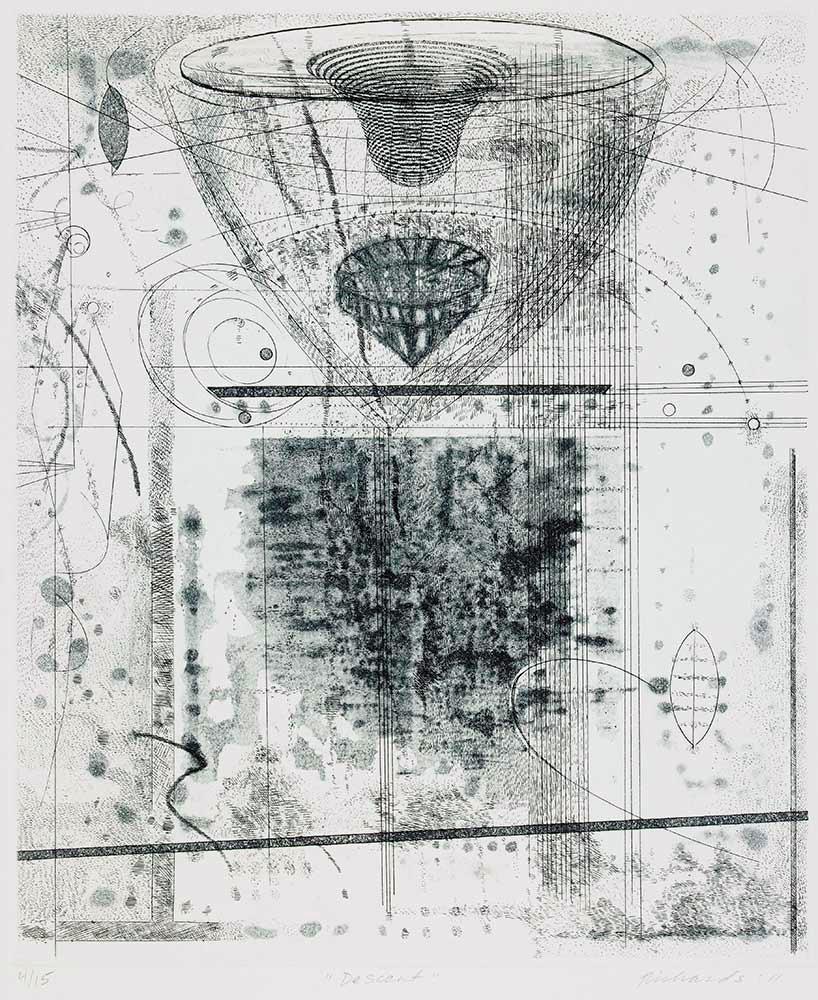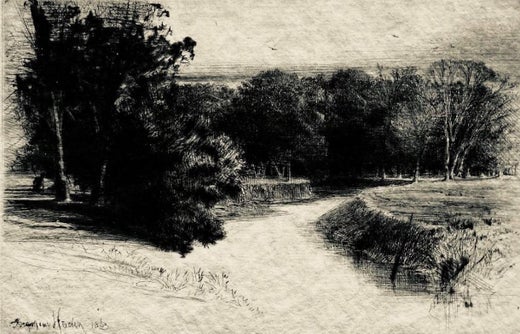Seymour HadenWareham Bridge1877
1877
About the Item
- Creator:Seymour Haden (1818-1910, British)
- Creation Year:1877
- Dimensions:Height: 9 in (22.86 cm)Width: 12 in (30.48 cm)
- Medium:
- Period:
- Condition:
- Gallery Location:Missouri, MO
- Reference Number:1stDibs: LU74732384531
Seymour Haden
Sir Francis Seymour Haden was an etcher, collector and surgeon, born in the UK in 1818. He studied at the Derby School, Christ's Hospital and University College in London. He also studied at the medical schools of the Sorbonne in Paris and Grenoble. He became a member of the Royal College of Surgeons in 1842, and he was made a fellow in 1857. He was an honorary surgeon to the Department of Science and Art from 1851–67 and in 1847, he settled into private practice. Haden was a vice-president of the obstetrical society of London and one of the founders of the Royal Hospital for Incurables in 1850. In 1858, Haden encouraged James McNeil Whistler to work from nature and consequently, Whistler dedicated his first set of etchings entitled French Set, to Haden. The etchings were printed by Auguste Delâtre in Paris and marketed, with some help from Haden, in London. In 1859, Whistler settled in London and often visited Haden's Sloane Street home. Haden became the president of the Society of Painter-Etchers, and he was partly responsible for the Rembrandt exhibition at the Burlington Fine Arts Club in 1879. His published works include The Etched Work of Rembrandt (1879), The Art of the Painter-Etcher (1890) and the Royal Society of Painter-Etchers (1891). In 1891, he was elected a member of the Athenæum and in 1894 his public service was rewarded with a knighthood. In 1905, his distinction was recognized abroad by honorary membership of the Institut de France, the Académie des Beaux-Arts and the Société des Artistes Français. He was awarded medals for etching at the Expositions Universelles in Paris in 1889 and 1900.
- ShippingRetrieving quote...Ships From: Missouri, MO
- Return PolicyA return for this item may be initiated within 2 days of delivery.
- HarmonvilleBy Daniel GarberLocated in Missouri, MODANIEL GARBER "Harmonville, Pennsylvania" c. 1925 Etching printed in black ink on wove paper. 7 7/8 x 11 3/4 inches, full margins. Signed, titled and inscribed "DG imp" in pencil, ...Category
1920s American Impressionist Landscape Prints
MaterialsEtching
- Canyon Road, Sante FeBy Will (William Howard) ShusterLocated in Missouri, MOCanyon Road, Santa Fe By. William Howard Shuster (American, 1893-1969) Signed Lower Right Edition of 100 Lower Center Titled Lower Left Unframed: 4" x 4.75" Framed: 15.75" x 15.25" ...Category
20th Century American Modern Landscape Prints
MaterialsEtching
- FodderBy John CostiganLocated in Missouri, MOFodder by John Costigan (1888-1972) Signed Lower Right Titled Lower Left 9.75" x 12.75" Unframed 17.5" x 19.75" Framed John Edwards Costigan was born in Providence, Rhode Island on ...Category
20th Century American Impressionist Landscape Prints
MaterialsEtching
- BostonBy John William HillLocated in Missouri, MOJohn William Hill (1812-1879) "Boston" 1857 Hand-Colored Engraving Site Size: 29 x 41 inches Framed Size: 39 x 52 inches Born in London, England, John William Hill came to America with his family at age 7. His father, John Hill, was a well-known landscape painter, engraver, and aquatintist. John William had a career of two phases, a city topographer-engraver and then, the leading pre-Rafaelite school painter in this country. Employed by the New York Geological Survey and then by Smith Brothers...Category
1850s Pre-Raphaelite Landscape Prints
MaterialsAquatint, Engraving
- Shere Mill PondBy Sir Francis Seymour Haden, R.A.Located in Missouri, MOShere Mill Pond, No. II (large plate). 1860. Etching and drypoint. Schneiderman 37.v/ix. 7 x 13 1/8 (sheet 10 3/4 x 16 3/8). This state is prior to publication in Études à l'Eau-Forte. Illustrated: Keppel The Golden Age of Engraving; Print Collector's Quarterly 1 (1911): 18; : Guichard, British Etchers, 1850-1940. A rich, brilliant proof with drypoint burr printed on white laid paper. Signed in pencil. ------------------------------------------------------------------------------------------- Shere Mill Pond, No. II was one of the most highly praised landscape prints of the etching revival. An impression was exhibited at the Royal Academy in 1861 under Haden’s pseudonym, H. Dean. Francis Seymour Haden used this anagram of his own name early in his career as an artist, in order to retain his anonymity and preserve his professional reputation as a surgeon. Biography: Sir Francis Seymour Haden (16 September 1818 - 1 June 1910), was an English surgeon, best known as an etcher. He was born in London, his father, Charles Thomas Haden, being a well-known doctor and lover of music. He was educated at Derby School, Christ's Hospital, and University College, London, and also studied at the Sorbonne, Paris, where he took his degree in 1840. He was admitted as a member of the College of Surgeons in London in 1842. In 1843-1844, with his friends Duval, Le Cannes and Colonel Guibout, he travelled in Italy and made his first sketches from nature. Haden attended no art school and had no art teachers, but between 1845 and 1848 he studied portfolios of prints belonging to a second-hand dealer named Love, who had a shop in Bunhill Row, the old Quaker quarter of London. Arranging the prints in chronological order, he studied the works of the great original engravers, Albrecht Dürer, Lucas van Leyden and Rembrandt. These studies, besides influencing his original work, led to his important monograph on the etched work of Rembrandt. By lecture and book, and with the aid of the memorable exhibition at the Burlington Fine Arts Club in 1877, he tried to give a true reflection of Rembrandt's work, giving a nobler idea of the master's mind by taking away from the list of his works many dull and unseemly plates that had long been included in the lists. His reasons were founded upon the results of a study of the master's works in chronological order, and are clearly expressed in his monograph, The Etched Work of Rembrandt critically reconsidered, privately printed in 1877, and in The Etched Work of Rembrandt True and False (1895). Haden's printmaking was invigorated by his much younger brother-in-law, James Whistler, at the Haden home in Sloane Street in 1855. A press was installed there and for a while Haden and Whistler collaborated on a series of etchings of the Thames. The relationship and project did not last. Haden followed the art of original etching with such vigour that he became not only the foremost British exponent of that art but brought about its revival in England. His strenuous efforts and perseverance, aided by the secretarial ability of Sir WR Drake, resulted in the foundation of the Royal Society of Painter-Etchers and Engravers. As president he ruled the society with a strong hand from its first beginnings in 1880. Notwithstanding his study of the old masters of his art, Haden's own plates were very individual, and are particularly noticeable for a fine original treatment of landscape subjects, free and open in line, clear and well divided in mass, and full of a noble and dignified style of his own. Even when working from a picture his personality dominates the plate, as for example in the large plate he etched after J.M.W. Turner's "Calais Pier," which is a classical example of what interpretative work can do in black and white. Of his original plates, more than 250 in number, one of the most notable was the large "Breaking up of the Agamemnon." An early plate, rare and most beautiful, is "Thames Fisherman". "Mytton Hall" is broad in treatment, and a fine rendering of a shady avenue of yew trees leading to an old manor-house in sunlight. "Sub Tegmine" was etched in Greenwich Park in 1859; and "Early Morning--Richmond", full of the poetry and freshness of the hour, was done, according to Haden, actually at sunrise. One of the rarest and most beautiful of his plates is "A By-Road in Tipperary"; "Combe Bottom" is another; and "Shere Mill Pond" (both the small study and the larger plate), "Sunset in Ireland," "Penton Hook," "Grim Spain" and "Evening Fishing, Longparish," are also notable examples of his genius. A catalogue of his works was begun by Sir William Drake and completed by Harrington in 1880. During later years Haden began to practise the sister art...Category
Late 19th Century Old Masters Landscape Prints
MaterialsEtching, Drypoint
- Ponte di Donna Onesta, VeniceBy John MarinLocated in Missouri, MOVery rare etching by John Marin. "Ponte di Donna Onesta, Venice" 1907 Original Etching Hand Signed Lower Right Titled Lower Left Edition: c. 30 Cat. Rais: ...Category
Early 1900s Abstract Landscape Prints
MaterialsEtching
- Mending the TearsBy Winslow HomerLocated in New York, NYWinslow Homer created this etching entitled “MENDING THE TEARS” in 1888. This is a lifetime impression signed by Homer and printed by the famous New York etcher George W. H. Ritchie...Category
1880s American Impressionist Figurative Prints
MaterialsEtching
- J.H. Woods’ Fruit Shop, ChelseaBy James Abbott McNeill WhistlerLocated in New York, NYJames Whistler (1834-1903), J.H. Woods’ Fruit Shop, Chelsea, etching and drypoint, 1887-88. Signed with the butterfly on the tab and annotated “imp,” also signed with the butterfly in pencil verso and numbered “1”. References: Kennedy 265 second state (of 2), Glasgow 327 second state (of 4). Trimmed by the artist around the plate mark except for the tab, in excellent condition. Printed in black ink on ivory laid paper, 3 3/4 x 5 1/8 inches. A fine impression of this great rarity; the print was never published. Glasgow accounts for four impressions. watermark: partial arms of Amsterdam(cf. Spink/Stratis/Tedeschi, watermark nos. 12ff.) This is before the third state in which heavy shading was added around the woman at the center, and the heads of figures at right and left of the figure are defined. In Glasgow’s fourth state the shading and the figure were removed; no impression is known of this state, but the state is inferred from the cancelled plate. According to Glasgow “Joseph Henry Wood had a greengrocer’s shop at 1 Park Walk...Category
1880s Impressionist Landscape Prints
MaterialsEtching, Drypoint
- La rentrée du Berger by Camille Pissarro - EtchingBy Camille PissarroLocated in London, GBLa rentrée du Berger by Camille Pissarro (1830-1903) Etching 7.6 x 10.9 cm (3 x 4 ¹/₄ inches) Stamped with initials C.P. lower left, and numbered 13/18 lower right This work was crea...Category
1880s Impressionist Landscape Prints
MaterialsEtching
- G Cooper: 'St Mary's Church, Oxford' etching on paperLocated in London, GBTo see our other views of Oxford and Cambridge , particularly suitable for wedding and graduation presents, scroll down to "More from this Seller" and below it click on "See all from...Category
19th Century Realist Landscape Prints
MaterialsEtching
- The Merry Beaglers engraving by John Harris after Harry Hall's 1845 paintingBy John Harris the YoungerLocated in London, GBJohn Harris after Harry Hall The Merry Beaglers c. 1845 48x65cm Aquatint with hand colouring The most famous beagling print there is, after the 1845 pa...Category
1840s Victorian Landscape Prints
MaterialsAquatint
- Guy Allen Full Moon Unframed PrintBy Guy AllenLocated in Coltishall, GBThe full moon is the lunar phase when the Moon appears fully illuminated from Earth’s perspective. This occurs when the Earth is located between the Sun and the Moon. This means tha...Category
21st Century and Contemporary Contemporary Prints and Multiples
MaterialsEtching, Paper





